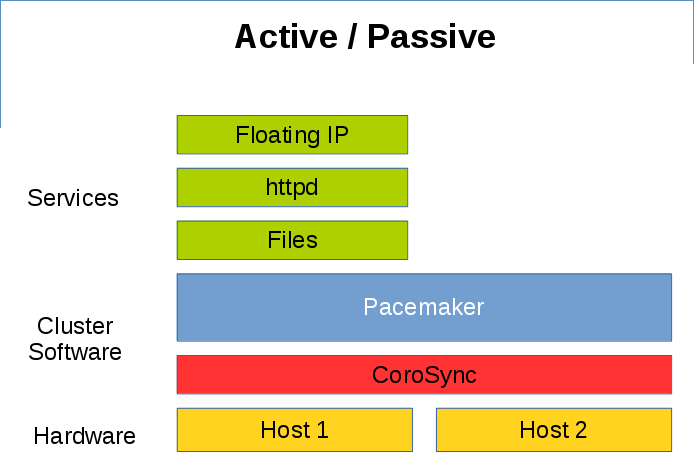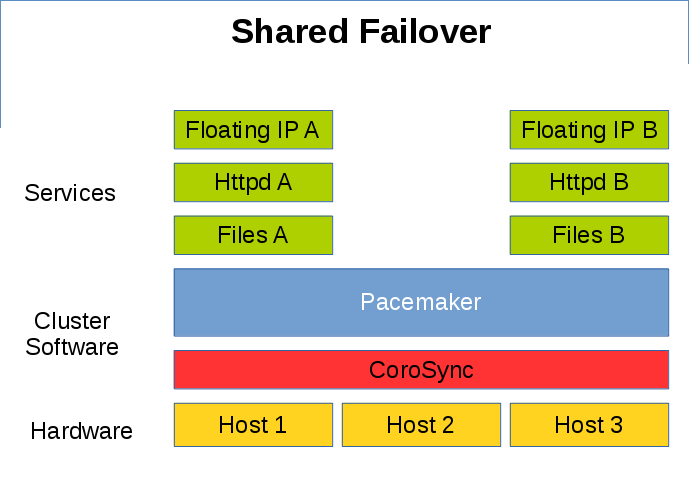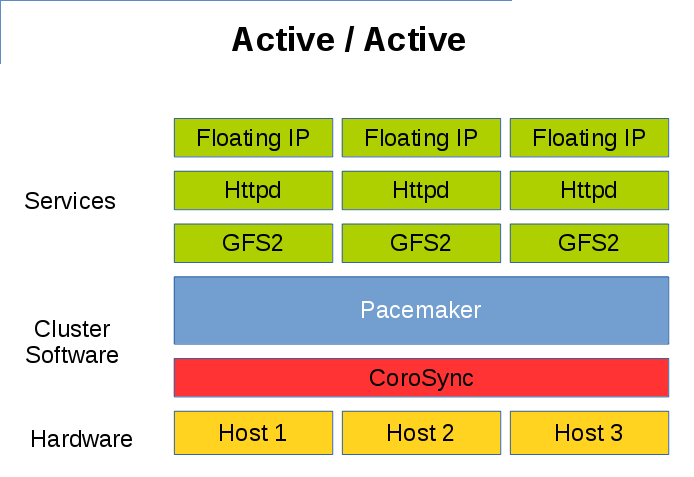A dirty trick.
Install packages
# yum groupinstall "Server with GUI" # yum install motif xterm # cat /etc/sysconfig/desktop PREFERRED=/usr/bin/mwm
Start X from multi-users.target
# systemctl isolate multi-user.target # startx
feichashao's Blog
A dirty trick.
Install packages
# yum groupinstall "Server with GUI" # yum install motif xterm # cat /etc/sysconfig/desktop PREFERRED=/usr/bin/mwm
Start X from multi-users.target
# systemctl isolate multi-user.target # startx
在 debug pacemaker/pcs/pcsd 的时候,我们通常需要知道,敲下 `pcs xxxx xxxx` 命令后,发生了什么动作。
在应用 pcs 进行管理的 pacemaker 集群中,每个节点都会启动一个 pcsd 守护进程,监听 2224/tcp 端口。随后,我们可以从任一节点中,通过 pcs 命令管理整个集群。
按照套路,通常这是一种 client/server 架构, pcs 命令行工具向相应节点的 pcsd 发送请求, pcsd 在相应节点完成动作。
然而实际与此有所出入。
实际上,真正对 pacemaker 执行操作的,是 pcs 这个命令行工具。pcsd 负责接收来自其他节点的请求,随之调用本地的 pcs 工具,最后由本地的 pcs 执行操作。
以 `pcs cluster start` 命令为例。在 Node A 中执行 `pcs cluster start`, Node A 本地的 cluster 相关服务将被启动。
在此操作中,不需要经过 pcsd. 即, pcs ---> execute. 具体过程如下。
继续阅读“Pacemaker管理工具中 pcs/pcsd 的关系”
ulimit 可以限制进程的资源使用量。在设置 ulimit 之后,如何验证各个资源限制是有效的?如何查看每个进程当前使用了多少资源?本文将尝试对多个设定值进行演示。
我们从 ulimit 中看到的设定值,都是 per-process 的。也就是说,每个进程有自己的 limits 值。
首先,limit的设定值是 per-process 的。在 Linux 中,每个普通进程可以调用 getrlimit() 来查看自己的 limits,也可以调用 setrlimit() 来改变自身的 soft limits。 而要改变 hard limit, 则需要进程有 CAP_SYS_RESOURCE 权限。另外,进程 fork() 出来的子进程,会继承父进程的 limits 设定。具体可参考 getrlimit/setrlimit/prlimit 的手册。
`ulimit` 是 shell 的内置命令。在执行`ulimit`命令时,其实是 shell 自身调用 getrlimit()/setrlimit() 来获取/改变自身的 limits. 当我们在 shell 中执行应用程序时,相应的进程就会继承当前 shell 的 limits 设定。
那么一个 shell 的初始 limits 是谁设定的? 通常是 pam_limits 设定的。顾名思义,pam_limits 是一个 PAM 模块,用户登录后,pam_limits 会给用户的 shell 设定在 limits.conf 定义的值。我们可以开启 pam_limits 的 debug 来查看大致过程:
在 limits.conf 中,对 test 用户设定 memlock 的 hard limit 为 102410. 当用户通过 SSH 登录后,可以看到 pam_limits 为该会话设定了 memlock=102410.
继续阅读“如何验证 ulimit 中的资源限制?如何查看当前使用量?”
之前为了确认 /proc/interrupts 文件第一列的缩进方式,看了一下相关源码,在这里做一些记录。
系统可用的中断数量主要由架构决定,x86 的具体数量可以参考以下定义。
/* kernel/irq/irqdesc.c */ 96 int nr_irqs = NR_IRQS; 97 EXPORT_SYMBOL_GPL(nr_irqs);
/* arch/x86/include/asm/irq_vectors.h */ 152 #define NR_IRQS_LEGACY 16 153 154 #define IO_APIC_VECTOR_LIMIT ( 32 * MAX_IO_APICS ) 155 156 #ifdef CONFIG_X86_IO_APIC 157 # define CPU_VECTOR_LIMIT (64 * NR_CPUS) 158 # define NR_IRQS \ 159 (CPU_VECTOR_LIMIT > IO_APIC_VECTOR_LIMIT ? \ 160 (NR_VECTORS + CPU_VECTOR_LIMIT) : \ 161 (NR_VECTORS + IO_APIC_VECTOR_LIMIT)) 162 #else /* !CONFIG_X86_IO_APIC: */ 163 # define NR_IRQS NR_IRQS_LEGACY 164 #endif
像我这样,不喜欢玩水,不喜欢寺庙,不去夜店,其实在泰国没啥好玩的。
只是,一年前亚航大促,给自己挖了个坑。澳门< ->曼谷,含税280元人民币。小便宜,必须占。
第一天,坐了最早的一班城际铁路去拱北,跟着众多跨境上班的人们快速通关到澳门。在机场吃完早餐,还有大把时间。(麦当劳土匪价,7-11良心价)
亚航的灰机通常停在“远机位”。在袖珍的澳门,“远机位”有不一样的含义:明明灰机就在眼前20米的地方,却要在摆渡车上呼吸着柴油,看着一位位乘客往上挤,关门,前行不到15秒,开门,登机......
前排的乘客端着ipad在看《大圣归来》,我偷看了2小时之后,到达曼谷了。话说,曼谷的廊曼机场已经走在移动互联网的最前沿,出入境手机全覆盖。在这里,你可以见识到入境官用粗壮的手指,一个字母一个字母地,在手机上点点点,点点点,点点点...
继续阅读“泰国:清迈,素可泰,曼谷”
对于一些重要应用,我们希望实现高可用(High-Availability). 在 RHEL7 中,可以使用 Pacemaker 达到这样的效果。
Pacemaker 是一个集群资源管理器,它负责管理集群环境中资源(服务)的整个生命周期。除了传统意义上的 Active/Passive 高可用,Pacemaker 可以灵活管理各节点上的不同资源,实现如 Active/Active,或者多活多备等架构。
下图是一个经典的 Active/Passive 高可用例子, Host1/Host2 只有一台服务器在提供服务,另一台服务器作为备机时刻准备着接管服务。

为了节省服务器资源,有时候可以采取 Shared Failover 的策略,两台服务器同时提供不同的服务,留有一台备用服务器接管失效的服务。

通过共享文件系统如 GFS2,也可以实现 Active/Active 的多活形式。

During logroate, if there comes a log entry, where will this log entry goes? To the rotated file, lost, or to the newly created file?
It depends.
In RHEL 6 (centos 6), logrotate works like below:
1. Rename the original file. For example, /var/log/messages --> /var/log/messages.1
2. Create a new file. In this example, create an empty /var/log/messages
3. Run post-rotate script. For rsyslog, it would send a HUP signal to rsyslogd.